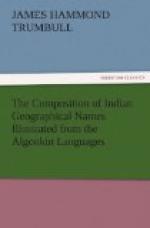Title: The Composition of Indian Geographical Names Illustrated from the Algonkin Languages
Author: J. Hammond Trumbull
Release Date: April 28, 2006 [EBook #18279]
Language: English
Character set encoding: ASCII
*** Start of this project gutenberg EBOOK the composition of Indian ***
Produced by Thierry Alberto, Henry Craig, Linda Cantoni, and the Online Distributed Proofreading Team at http://www.pgdp.net (This file was produced from images generously made available by the Canadian Institute for Historical Microreproductions (www.canadiana.org).)
THE COMPOSITION OF
Indian geographical names,
ILLUSTRATED FROM THE
Algonkin languages.
BY J. HAMMOND TRUMBULL.
Press of
case, Lockwood & Brainard,
Hartford, Conn.
[Transcriber’s Note: Published 1870]
* * * * *
[Transcriber’s Note: The original book contains some diacriticals that are represented in this e-text as follows:
1. A macron is represented by an =, e.g. [=a]
2. A breve is represented by a ), e.g., [)a]
3. [n] represents a superscripted n (see Footnote 4).
4. [oo] represents an oo ligature (see Footnote 4.)]
* * * * *
ON THE COMPOSITION OF
Indian geographical names.
A proper name has been defined to be “a mere mark put upon an individual, and of which it is the characteristic property to be destitute of meaning."[1] If we accept this definition, it follows that there are no proper names in the aboriginal languages of America. Every Indian synthesis—names of persons and places not excepted—must “preserve the consciousness of its roots,” and must not only have a meaning but be so framed as to convey that meaning with precision, to all who speak the language to which it belongs. Whenever, by phonetic corruption or by change of circumstance, it loses its self-interpreting or self-defining power, it must be discarded from the language. “It requires tradition, society, and literature to maintain forms which can no longer be analyzed at once."[2] In our own language, such forms may hold their places by prescriptive right or force of custom, and names absolutely unmeaning, or applied without regard to their original meaning, are accepted by common consent as the distinguishing marks of persons and places. We call a man William or Charles, Jones or Brown,—or a town, New Lebanon, Cincinnati, Baton Rouge, or Big Bethel—just as we put a number on a policeman’s badge or on a post-office box, or a trademark on an article of merchandise; and the number and the mark are as truly and in nearly the same sense proper names as the others are.




